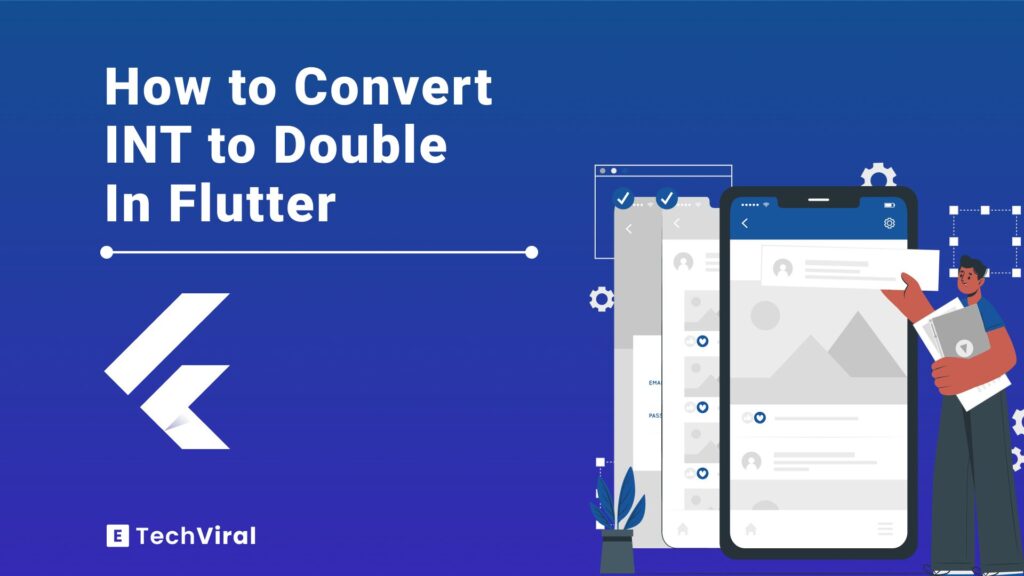In Flutter app Development, you’ll work with different kinds of data, like int (integer) and double (0.0). Sometimes, you need to switch from int to double to make your app work better.
This post is here to show you how to convert int to double in a few simple steps. Whether you’re new to coding or just new to Flutter, you’ll find this guide helpful.
We will share why converting int to double is important, the converting process and the practical examples with code. So let’s get started.
What is Int and Double?
When we talk about “int” in Flutter, we’re referring to whole numbers. Think of it like counting apples: you can have 1, 2, or 100 apples, but not 1.5 apples. That’s where “double” comes in. Double allows you to have numbers with decimals, like 1.5, making it perfect for more precise measurements or calculations.
Now, you might wonder why we need these int and double in flutter app development? Well, sometimes you only need whole numbers, and other times you need that extra precision. By choosing the right type, you can make your code more efficient and avoid errors down the line.
Why Convert int to double?
Ever wondered why you might need to switch from an int to a double in Flutter? Well, let’s dive into some everyday situations where this conversion comes in handy.
Here’s the common scenarios requiring conversion:
- Precision Matters: When you’re working with numbers that need more accuracy than whole numbers, like calculating percentages or dealing with measurements, converting to double is the way to go.
- Mixing Types: Sometimes, you’ll find yourself needing to use both int and double in a calculation. To keep things running smoothly, converting the int to a double is a smart move.
What are The Benefits of using double over int?
- Flexibility: Double gives you the freedom to work with both whole numbers and fractions, making your code more versatile.
- Compatibility: When you’re using external libraries or APIs that expect double values, converting your ints ensures everything works together seamlessly.
Step-by-Step Conversion of Int to Double
Converting an integer to a double in Flutter is simple. Just use the .toDouble() method. Here’s how:
- Start with Your int: Let’s say you have an integer, int myNumber = 5;.
- Use .toDouble(): To convert it to a double, do this: double newNumber = myNumber.toDouble();.
- That’s It!: Now, newNumber is a double, 5.0.
But what if something goes wrong? It’s rare, but let’s be ready.
Handling Exceptions During Conversion
Sometimes, things don’t go as planned. If there’s an error during conversion, we can catch it and handle it gracefully.
- Try-Catch Block: Wrap your conversion code in a try-catch block.
- Try: Inside the try block, do the conversion.
- Catch: If there’s an error, the catch block will handle it. You can show an error message or take other actions.
Here’s an example:
try {
double newNumber = myNumber.toDouble();
} catch (e) {
print("Oops! Something went wrong: $e");
}
You may also want to read:
How to Convert Int to Double With Practical Example?
Let’s dive into some real-world examples to see how we can apply what we’ve learned.
Imagine you’re creating a Flutter app where users enter their age, but you need it as a double for some calculations. Here’s how you can convert it:
- Get User Input: Let’s say the user enters their age as an integer.
int userAge = 25;
- Convert to Double: Use the .toDouble() method to convert it.
double ageInDouble = userAge.toDouble(25);
- Use the Converted Value: Now, you can use ageInDouble in your calculations.
Using Conversion in Mathematical Operations
Sometimes, you need to convert integers to doubles for precise calculations. Here’s an example:
- Define Integers: Let’s say you have two integers.
int length = 10; int width = 3;
- Convert to Double: Convert one or both to double.
double lengthInDouble = length.toDouble();
- Perform Calculation: Now, you can get a precise result for division.
double area = lengthInDouble / width;
In both examples, converting from int to double helps us achieve more accurate results and meet our app’s requirements. Practice these conversions in your Flutter projects to see the difference they make!
Tips for Smooth Conversion
Converting int to double in Flutter can be super easy if you keep a few things in mind. Here’s how to make sure your conversions are smooth as butter:
- Keep It Simple: Use the .toDouble() method. It’s straightforward and does the job well.
- Stay Alert: Watch out for null values. They can cause errors. Always check if your int is not null before converting.
- Be Consistent: Stick to one method of conversion throughout your code. It keeps things tidy and easy to read.
Which Mistakes You Should Avoid when Converting Int to Double?
- Don’t Mix Types: Avoid using int and double together in calculations. Convert your ints to doubles first to keep things consistent.
- Watch Your Math: Remember, dividing two ints gives you an int. To get a double result, at least one number needs to be a double.
- Handle Exceptions: Sometimes things go wrong. Use try-catch blocks to handle any errors during conversion gracefully.
Conclusion
That’s a wrap! We’ve covered the basics of turning an int into a double in Flutter. Remember, practice makes perfect. So, go ahead and try out what you’ve learned in your own Flutter projects. Keep experimenting and you’ll get the hang of it in no time!
FAQ’s
Can I convert a double back to an int in Flutter?
Yes, you can! Use the .toInt() method to change a double back to an int. This is useful when you need whole numbers again. Just keep in mind that this conversion might round off your number, so be sure to check the result to make sure it’s what you expect.
Will converting an int to a double affect its value?
Nope, converting an int to a double won’t change its value. The number stays the same; it just gains the ability to handle decimals. This is great for when you need more precision in your calculations or when working with certain Flutter widgets that require doubles.
What happens if I try to convert a very large int to a double?
Converting a large int to a double in Flutter is usually fine, but if the number is too big, you might lose some precision. This is because doubles have a limit on how accurately they can represent very large numbers. So, keep an eye on your results when working with big numbers.
Can I use type conversion in conditional statements?
Absolutely! You can use type conversion in conditional statements in Flutter. For example, you might convert an int to a double and then check if it’s greater than a certain value. This can be handy for making decisions based on dynamic data types in your app.











